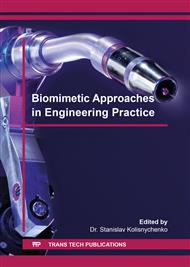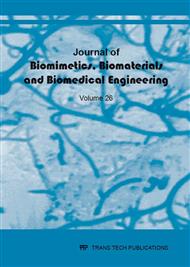[1]
Y. X. LU. The significance and development of bionics. Scientific Chinese, 2004, 4: 22-24.
Google Scholar
[2]
Q. S. LUO, B.L. HAN, X. C. ZHAO, et al. Modern biomimetic robots design. Publishing House of Electronics Industry, Beijing, (2008).
Google Scholar
[3]
R. SIDDALL, M. KOVAC. Launching the Aqua MAV: bioinspired design for aerial-aquatic robotic platforms. Bioinspiration & Biomimetics, 2014, 9(3): 1-15.
DOI: 10.1088/1748-3182/9/3/031001
Google Scholar
[4]
B. ESPIAU, P. SARDAIN. The anthropomorphic biped robot BIP2000. International Conference on Robotics and Automation, 2000, pp.3396-4001.
DOI: 10.1109/robot.2000.845354
Google Scholar
[5]
H.Y. XU, Y.L. FU, S.G. WANG, et al. Research on biomimetic robotics. Robot, 2004, 26(3) : 283-288.
Google Scholar
[6]
G. WANG, Q. HUANG, J.H. GENG, et al. Cooperation of dynamic patterns and sensory reflex for humanoid walking. International Conference on Robotics and Automation, 2003, pp.2472-2477.
DOI: 10.1109/robot.2003.1241964
Google Scholar
[7]
Boston Dynamics. CHEETAH - fastest legged robot[EB/OL].
Google Scholar
[2013]
http : /www. bostondynamics. com/robot_cheetah. html.
Google Scholar
[8]
X.B. CHEN, F. GAO, C.K. QI, et al. Gait planning for a quadruped robot with one faulty actuator. Chinese Journal of Mechanical Engineering, 2015 , 28(1) : 11-19.
DOI: 10.3901/cjme.2014.1107.167
Google Scholar
[9]
M. FUJITA, Y. KUROKI, T. ISHIDA , et al. A small humanoid robot SDR-4X for entertainment applications. International Conference on Advanced Intelligent Mechatronics , 2003, pp.938-943.
DOI: 10.1109/aim.2003.1225468
Google Scholar
[10]
P. Sardain, G. Bessonnet. Gait analysis of a human walker wearing robot feet as shoes. Robotics and Automation, 3, (2001) 2285-2292.
DOI: 10.1109/robot.2001.932963
Google Scholar
[11]
M. RAIBERT, K. BLANKESPOOR, G. NELSON, et al. Bigdog, the rough-terrain quadruped robot. Proceedings of The International Federation of Automatic Control, 2008, pp.10822-10825.
DOI: 10.3182/20080706-5-kr-1001.01833
Google Scholar
[12]
B.Y. CUI, L.W. CHEN. Analysis of Kinematics and Design of Structure Parameters for A Bionic Parallel Leg. Journal of Biomimetics Biomaterials and Biomedical Engineering , 20(2014)23-33.
DOI: 10.4028/www.scientific.net/jbbbe.20.23
Google Scholar
[13]
Hirose M, Ogawa K. Honda humanoid robots development. Philosophical Transactions of the Royal Society of London A: Mathematical, Physical and Engineering Sciences, 2007 , 365(1850) : 11-19.
DOI: 10.1098/rsta.2006.1917
Google Scholar
[14]
Y. SHU, D. SUN, Q. L. HU, et al. Lower Limb Kinetics and Kinematics during Two Different Jumping Methods. Journal of Biomimetics, Biomaterials and Biomedical Engineering, 2015, 22: 29-35.
DOI: 10.4028/www.scientific.net/jbbbe.22.29
Google Scholar
[15]
P.S. MA, W.H. ZHENG. The fuzzy-neural network control for quadruped walking robot. Robot, 1997, 19(1): 56-60.
Google Scholar
[16]
H.P. SHEN, X.M. MA, Q.M. MENG, et al. Research Progress on Bionic Robots and Research Issues of Bionic Mechanism. Journal of Changzhou University, 2015, 27(1): 1-10.
Google Scholar
[17]
Y.B. LI, B. LI, X.W. RONG, et al. Mechanical design and gait planning of a hydraulically actuated quadruped bionic robot. Journal of Shandong University, 2011, 41(5): 32-36.
Google Scholar
[18]
Z.Y. Xia, Z. Xia, L. Liu, et al. Design aspects and development of humanoid robot THBIP-2. Robotica, 2008 , 26(01) : 109-116.
DOI: 10.1017/s0263574707003645
Google Scholar
[19]
H.B. WANG, Z.Y. QI, Z.W. HU, et al. Application of parallel leg mechanisms in quadruped/ biped reconfigurable walking robot. Chinese Journal of Mechanical Engineering, 2009, 45(8) : 24-32.
DOI: 10.3901/jme.2009.08.024
Google Scholar
[20]
R. F. Boian, M. Bouzit, G. C. Burdea, et al. Dual Stewart platform mobility simulator.Proceeding of the 2005 IEEE9th International Conference on Bionic robotics, 2005, pp.550-555.
DOI: 10.1109/icorr.2005.1502023
Google Scholar
[21]
Y. LU, Y. SHI, B. HU. Kinematic analysis of two novel 3UPU I and 3UPU II PKMs. Robotics and Autonomous Systems, 2008 56(4): 296-305.
DOI: 10.1016/j.robot.2007.09.005
Google Scholar
[22]
H.B. WANG, X. YANG, Xi.Q. ZHENG, et al. Design and Analysis for Minimally Invasive Vascular International Surgical Robot System. Advanced Science Letters, 2012, 8: 31-36.
Google Scholar



